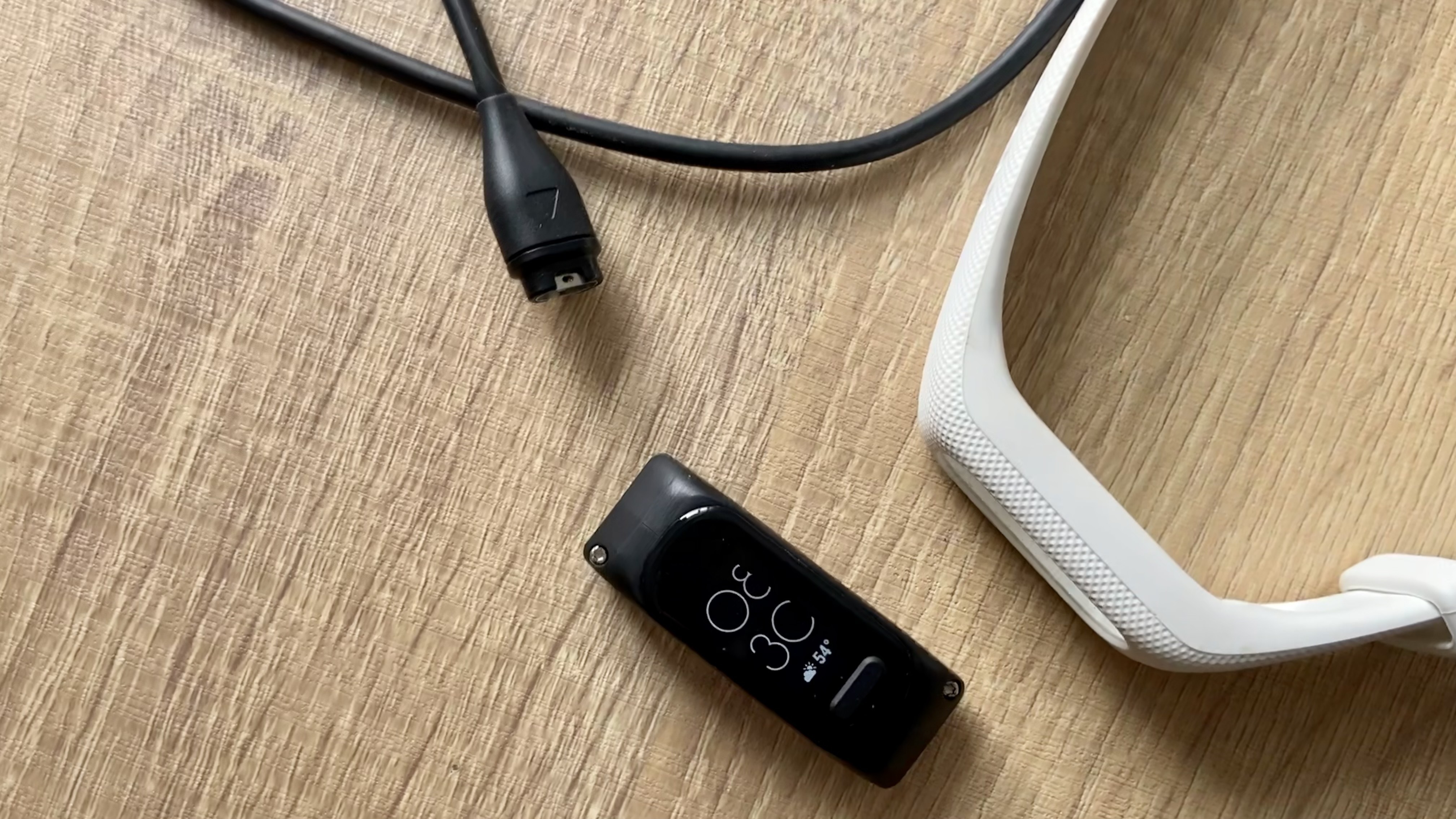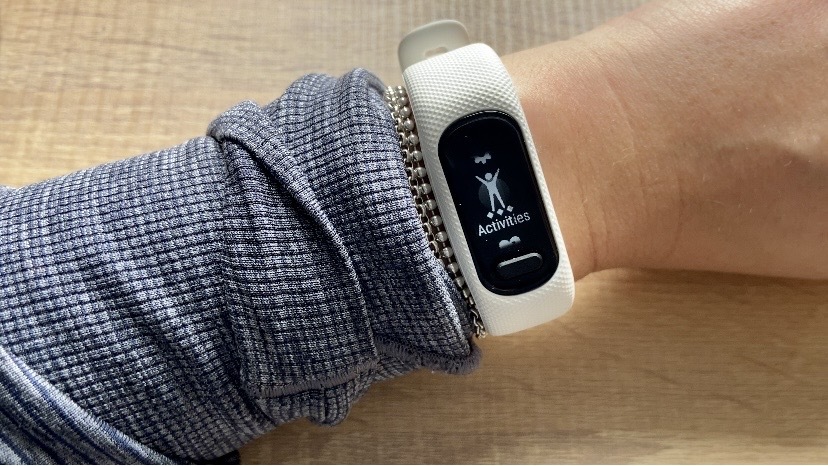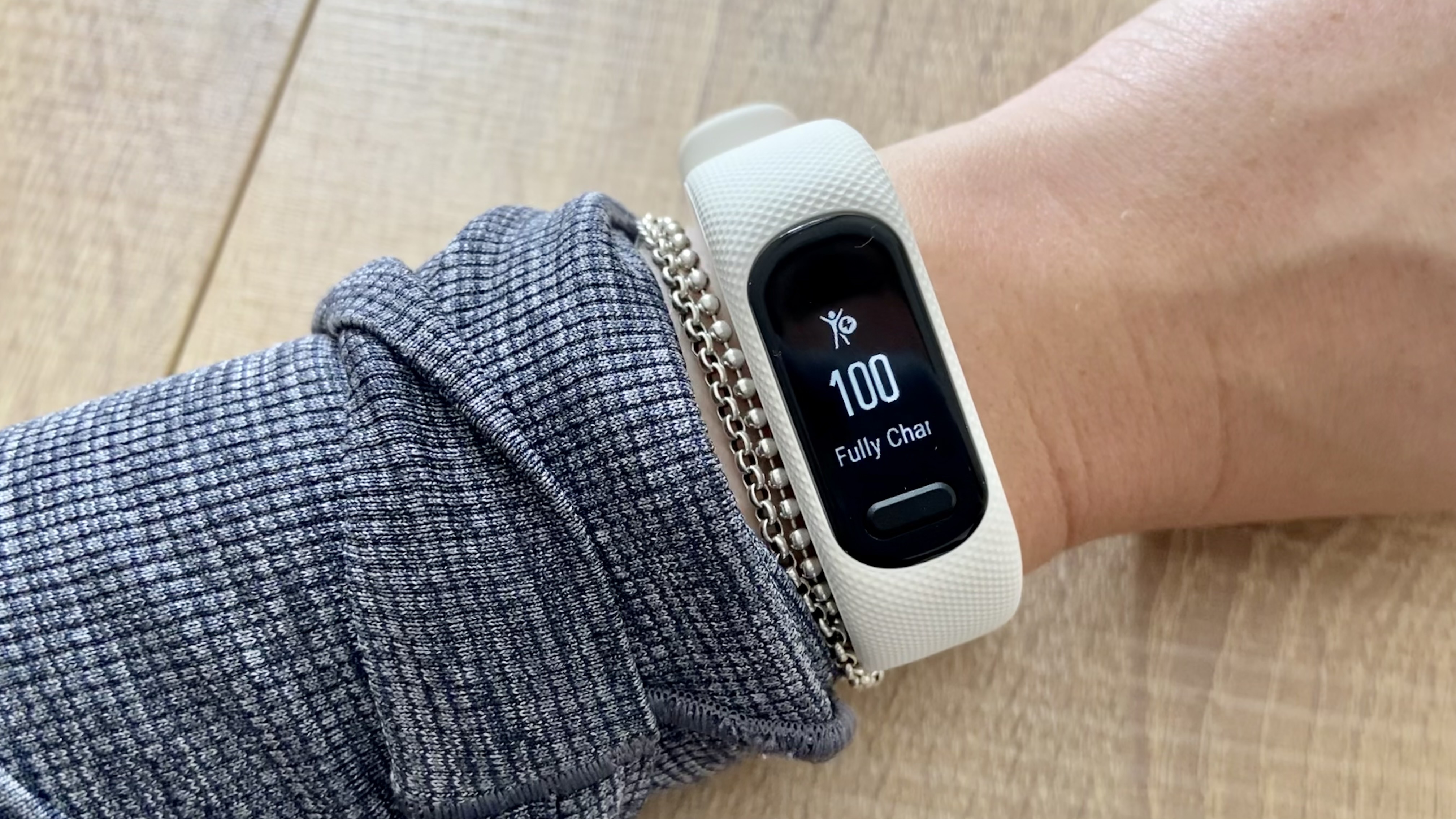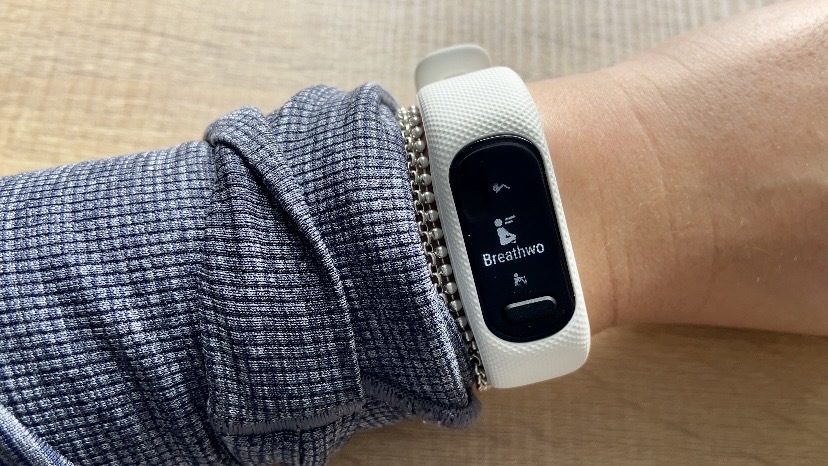Tom's Guide Verdict
It’s a good little fitness tracker, but without onboard GPS, the Garmin Vivosmart 5 falls short compared to the Fitbit Charge 5.
Pros
- +
Good sleep tracking
- +
Lightweight
- +
Improved design compared to Vivosmart 4
- +
Swappable bands
Cons
- -
No onboard GPS
- -
A little fiddly to use
- -
Small screen
Why you can trust Tom's Guide
It’s been a while since we saw a new fitness tracker from Garmin, but the company proved it’s not just focusing on the big-boy adventure watches of late, with its Vivosmart 5. The tracker is back, four years after the launch of the Vivosmart 4, with an improved, lightweight design, but how does it stack up when compared to some of the best fitness trackers on the market?
I’d argue that most fitness tracker consumers are looking for an easy-to-wear device that’ll help them keep an eye on their health and activity levels. If that’s the brief, the Vivosmart 5 meets it. Yet in 2022, the small screen and the lack of onboard GPS feels a little lackluster. Read my full Garmin Vivosmart 5 review to find out more.
Garmin Vivosmart 5 review: Price and availability
The Garmin Vivosmart 5 went on sale in April 2022, costing $149.99 / £129.99 / AU$229, which is a pretty standard price for a fitness tracker these days. At the time of writing, the tracker is available in black, white, and cool mint.
It’s cheaper than the likes of the Fitbit Charge 5, which retails at $179.99, and the Garmin Lily which starts at $199, but I’d argue that if you’re serious about running or cycling, it’s worth forking out for the Charge 5 to get on-board GPS, or the Garmin Forerunner 55, which is a fantastic entry-level running watch. Check out our Garmin coupon codes whilst you're at it: you may be able to secure a discount.

Garmin Vivosmart 5 review: Design and display
Rather than completely redesigning the tracker, Garmin has made some small, yet significant tweaks to the design of the Vivosmart 5 to improve its usability. The main one is adding a physical button that allows you to navigate around the watch, pause, and stop an activity. While this might seem like a strange choice, it’s a welcome change, especially as we found the touchscreen on the Vivosmart 4 to be a little fiddly to use and occasionally unresponsive.
The Vivosmart 5 sports a monochrome OLED display that is 66% larger than that of its predecessor. The size increase makes reading messages easier, and unlike the Vivosmart 4, text can now scroll across the screen, which prevents them from being cut off. The screen also displays three health metrics at any given time.
Size: 19.5 x 10.7 x 217mm (small), 19.5 x 10.7 x 255mm (large)
Screen: Grayscale OLED
GPS: No
Garmin pay: No
Sports modes: 14 total, 10 available on watch at a time
That said, the display on the Vivosmart 5 is still not the easiest screen to view, especially when you’re on the move, and if you’re someone who likes to check your Whatsapp messages from your wrist, you might struggle to do so here. The black-and-white screen does feel a little old when a lot of fitness trackers including the Fitbit Charge 5 and the Amazon Halo View have moved on to brighter color screens.
Get instant access to breaking news, the hottest reviews, great deals and helpful tips.
On the wrist, I found the Vivosmart 5 wasn’t quite as beginner-friendly as some of the best Fitbits, and it took me a good 10 minutes to work out how to pause my hike (you have to hold down on the button until the stop sign appears), despite being a Garmin user for more than 10 years. That said, once you’ve had the fitness tracker on your wrist for a few days, it becomes second nature.

It’s also worth noting that the watch comes in two different sizes — the small/medium band is designed for wrists with a circumference between 122mm and 188mm, and the large band is suited for wrists with a circumference between 148mm and 228mm.
The Vivosmart 5 gives you the option to swap between bands, which is a nice extra, although you do have to use Garmin’s official ones at the moment. It’s likely third parties will design extras soon. To swap the band, just bend the band back a little and pop the tracking unit out — no tools or screws needed.
Garmin Vivosmart 5 review: Battery life
Garmin says the Vivosmart 5 has a battery life of around seven days, and this was pretty accurate during testing, as long as the all-day blood oxygen monitoring was turned off. With the all-day monitoring turned on, the battery life was reduced to around three days max.
This is still a good deal longer than the likes of the Apple Watch Series 7, but still not the greatest. That said, I’d argue that blood oxygen monitoring is most useful for sleep tracking, so it’s probably not a metric you’d need to leave on for 24 hours a day, and Garmin does give you the option to only turn it on during sleep.

With blood oxygen monitoring turned on at night and recording at least one workout a day, I was able to go around five days between charges. The battery charged from being completely flat to 100% in around 2 hours.
Garmin Vivosmart 5 review: Health tracking
As I mentioned, one of the main selling points of a fitness tracker is health tracking. The Vivosmart 5 gives you GPS tracking through your phone, blood oxygen monitoring, and continuous heart rate monitoring.
Like a lot of the other best Garmin watches, the Vivosmart 5 is pretty good on a sleep tracking front. It’s lightweight and comfortable enough to wear when you’re sleeping (compared to the Garmin Fenix 7, it’s quite literally, a dream), and gives you a good picture of your sleep patterns. Like a lot of the more premium Garmin watches, the watch will also give you a body battery score when you wake up, which takes into account your previous day’s activity levels, and your sleep quality.
The body battery tool is similar to Fitbit’s daily readiness score, but Garmin has one huge benefit over Fitbit in this category — unlike Fitbit, it doesn’t put its premium tracking features behind a paywall. All of Garmin’s data is free of charge and available in the Garmin Connect App, which is intuitive and easy to use.

Another benefit of the body battery score over the Daily Readiness Score is that it changes in real time. If you were, for example, planning a tough run or a hard gym session after a day of work, but that day has been particularly grueling, your body battery will reflect that. You can view your body battery on the Vivosmart 5; there’s a line graph that shows how your score has changed over the past 4 hours, accompanied by a note saying whether your Body Battery is “charging” or “draining.”
As well as body battery and sleep, the Vivosmart 5 has stress tracking, breathing exercises, and high and low heart rate notifications. The Vivosmart 5 also has some of Garmin’s latest safety features, including fall detection, emergency SOS alerts, and the option to let contacts track you in real-time.
With the Vivosmart 5, Garmin has gotten rid of the barometric altimeter that could be found on the Vivosmart 4, so you can no longer track how many floors you’ve climbed each day, In my opinion, though, that’s no real loss as it’s not really a metric many people would care about.
Garmin Vivosmart 5 review: Workout tracking
When it comes to workout tracking, the Vivosmart 5 has definitely been designed for casual activities — in other words, you definitely wouldn’t grab this watch if you’d signed up to your first marathon. (If you have, return the Vivosmart 5 or chuck it on eBay and get yourself a Forerunner 55, ASAP.) The Vivosmart 5 is great if you want to count your steps, keep track of how many minutes of intense exercise you’ve done, and see how many calories you’ve burned, but not so great if you’re super serious about your training (although I’d argue no fitness tracker really is).
Once again, compared to Fitbit, the amount of data you can access in the Garmin Connect App comes up trumps. You can see a huge amount of really insightful information should you wish, including things like your moving paces versus your average pace, or how much sweat you’ve lost. I’d argue the average wearer of the Vivosmart 5 probably wouldn’t want such in-depth data, but kudos to Garmin for putting it there anyway.

The Vivosmart 5 has 14 different sports modes to choose from — including HIIT training, Pilates, and indoor running, which weren’t available on the Vivosmart 4. The tracker itself can only store 10 different sports modes at a time, so you’ll have to select your preferred activities in the Garmin Connect app before heading out. This is also where you can customize the data screens for each sports mode, add alerts, and turn on and off things like auto-lap, alerts, and rep counting. Once they are loaded, it’s easy to scroll through them on the tracker by clicking the button, then using the touchscreen to scroll up and down.
Of course, the biggest drawback when it comes to workout tracking with the Vivosmart 5 is the lack of onboard GPS. During testing, I found the connected GPS was ever-so-slightly inaccurate on shorter runs around the city — my Fenix 6 would read 5 miles, whereas the Vivosmart 5, taking GPS data from my iPhone 11, would read 5.2. What’s 0.2 miles between friends, right? However, over longer distances, this adds up, and over a 10-mile hike, the Vivosmart 5 added on an extra mile and a half. Once again, this isn’t that bad if you’re just using the tracker casually, but if you’re training for an event, I’d recommend getting something with built-in GPS tracking.

From a smartwatch perspective, the Vivosmart 5 has all of the basic features we’ve come to expect from fitness trackers, such as push notifications, media controls, and timers. There’s no onboard music storage; however, you can use the watch as a remote control for your phone’s media, which I appreciate, as I don’t want to have to dig my phone out of my pocket every time I want to skip the ads on my podcast.
Garmin Vivosmart 5 review: Garmin Connect app
As I’ve already mentioned, the Garmin Connect app, in my opinion, is one of the best of its kind. It presents a huge amount of data in a way that’s clear and simple to understand compared to competitors (Whoop, I’m looking at you). It’s also easy to customize your tracker, view your current day’s stats at a glance, and scroll back through recent workouts.
It’s also fantastic that everything is free. Compared to Fitbit Premium, which requires you to pay $10 a month to access in-depth sleep, activity, and recovery data, Garmin gives you all of it for free. That said, there’s far fewer workouts on the Garmin Connect app, and none of the meditation or mindfulness sessions you get on Fitbit Premium. There are, however, more running and cycling plans, although, like I’ve already mentioned, if you’re serious about training for an event, you’d probably want to upgrade to one of the better Garmin running watches.
Garmin Vivosmart 5 review: Verdict
If you have a Vivosmart 3 or 4 on your wrist, there’s no doubt about it — the Vivosmart 5 is a huge upgrade. It’s easier to use thanks to the physical button, and it’s a solid fitness tracker that will give you a good insight into your day-to-day health. It also doesn’t record insightful data and then stick it behind a paywall, which is nice.
That said, as a lifelong Garmin wearer, when looking at the Vivosmart 5 as a tracker alone, I’d probably opt for the Fitbit Charge 5 because of the color screen and the onboard GPS. Fitbit’s tracker is slightly easier to use, and things like GPS tracking and Fitbit Pay mean I can leave my phone on my desk at work, and head out for a distraction-free run on my lunch break.
It’s also worth mentioning once more that if you’re really serious about getting in shape, it’s worth upgrading to something like the Forerunner 55, which is a fantastic entry-level running watch. It’s often on sale, so will probably only cost you around $40 more than the Vivosmart 5, but is a far better watch to have on your wrist, especially when it comes to real-time data.

Jane McGuire is Tom's Guide's Fitness editor, which means she looks after everything fitness related - from running gear to yoga mats. An avid runner, Jane has tested and reviewed fitness products for the past five years, so knows what to look for when finding a good running watch or a pair of shorts with pockets big enough for your smartphone. When she's not pounding the pavements, you'll find Jane striding round the Surrey Hills, taking far too many photos of her puppy.

